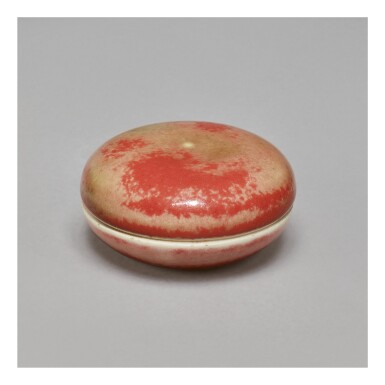
A PEACHBLOOM-GLAZED SEAL PASTE BOX AND COVER, KANGXI MARK AND PERIOD
Auction Closed
September 22, 02:00 PM GMT
Estimate
80,000 - 120,000 USD
Lot Details
Description
A PEACHBLOOM-GLAZED SEAL PASTE BOX AND COVER
KANGXI MARK AND PERIOD
清康熙 豇豆紅釉印泥蓋盒 《大清康熙年製》款
of compressed globular form, the domed cover glazed in variegated tones of copper-red ranging from pale pink to mushroom, transmuting to an 'unripe peach' green at one side, mottled with patches of strawberry-red including an area encircling the rim, the box with a similar pinkish glaze and strawberry-red encircling the foot, the interior and recessed base glazed white, the latter with a six-character mark in underglaze blue in three columns, wood stand (3)
Diameter 2⅞ in., 7.2 cm
Collection of Edward T. Chow (1910–1980).
Sotheby's Hong Kong, 25th November 1980, lot 69.
來源
仇焱之 (1910-1980年) 收藏
香港蘇富比1980年11月25日,編號69
Exhibition of Ancient Chinese Ceramics from the Collection of the Kau Chi Society of Chinese Art, Art Gallery, The Chinese University of Hong Kong, Hong Kong, 1981, cat. no. 129.
展覽
《求知雅集珍藏•中國古陶瓷展》,香港中文大學文物館,香港,1981年,編號129
Cécile and Michel Beurdeley, La Céramique Chinoise, Fribourg, 1974, pl. 98.
出版
Cécile 及 Michel Beurdeley,《La Céramique Chinoise》,佛立堡 ,1974年,圖版98
This exquisite box, with its thinly potted body and brilliant peachbloom glaze suffused with watery-green, is testament to the aesthetic refinement of the early Qing court. Small boxes for storing seal paste were often made in the preceding Ming dynasty from organic materials; standing as symbols of simplicity and a life lived in tune with nature, concepts at the center of Daoist and Neo-Confucian philosophy. The peachbloom glaze, especially cherished because of its deceptive simplicity and unpredictability, provided scholar-officials with an attractive porcelain alternative.
Similar peachbloom-glazed boxes can be found in the Palace Museum, Beijing, illustrated in Kangxi, Yongzheng, Qianlong. Qing Porcelain from the Palace Museum Collection, Hong Kong, 1989, p. 141, pl. 124; in the National Palace Museum, Taipei, included in the Special Exhibition of K’ang-hsi, Yung-cheng and Ch’ien-lung Porcelain Ware from the Ch’ing Dynasty, National Palace Museum, Taipei, 1986, cat. no. 11; and in the Metropolitan Museum of Art, New York, illustrated in Suzanne Valenstein, A Handbook of Chinese Ceramics, New York, 1989, p. 141. See also eight boxes from the collection of Peter A.B. Widener, in the National Gallery of Art, Washington D.C., published in Virginia Bower et al., The Collections of the National Gallery of Art. Systematic Catalogue: Decorative Arts, Part I, Washington, 1998, pp 58-60.
The inclusion of a similar box on the famous handscroll Guwantu (‘Pictures of Antiques’) that depicts contemporary and antique works of art in the imperial collection of the Yongzheng Emperor (1723-1735) attests to the high value and prestige placed on peachbloom-glazed boxes by members of the imperial family; see Regina Krahl, “Peachbloom”, Chinese Porcelain from the 15th to the 18th Century, Eskenazi, London, 2006, fig. 3.
本印泥盒薄胎細緻,釉色明艷,淡綠斑紋如水,展示清初美學成就。明代時印泥盒常以有機物料製作,象徵天人合一、簡樸生活等儒家及道家哲理。豇豆紅簡麗素雅,而且燒成釉色有仗天成,因而深受珍重,瓷製泥印盒,亦受文士喜愛。
豇豆紅印泥盒可比數例,其一藏於北京故宮博物院,載於《故宮珍藏康雍乾瓷器圖錄》,香港,1989年,頁141,圖版124;另一例存於台北國立故宮博物院,曾展於《清康雍乾名瓷》,國立故宮博物院,台北,1986年,編號11;紐約大都會藝術博物館亦藏一例,圖載於 Suzanne Valenstein,《A Handbook of Chinese Ceramics》,紐約,1989年,頁141。八例出自Peter A.B. Widener 收藏,現存於華盛頓國家藝廊,載於 Virginia Bower 等,《The Collections of the National Gallery of Art. Systematic Catalogue: Decorative Arts》,卷1,華盛頓,1998年,頁58-60。
豇豆紅印泥盒,深受宮廷皇室青睞。《古玩圖》手卷記錄雍正皇帝御藏珍品,豇豆紅印泥盒即在其中,參考康蕊君,〈Peachbloom〉,《Chinese Porcelain from the 15th to the 18th Century》,埃斯卡納齊,倫敦, 2006年,圖3。
